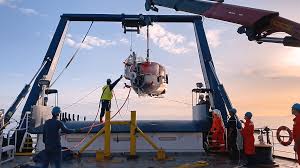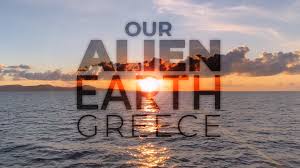The making of our alien earth: the undersea volcanoes of Santorini, Greece

Mike Toillion
Athens: The following expedition marks the third installment of NASA Astrobiology’s fieldwork series, the newly rebranded Our Alien Earth, streaming on NASA+. Check out all three episodes following teams of astrobiologists from the lava fields of Holuhraun, Iceland, to the Isua Greenstone Belt of Greenland, and finally, the undersea volcanoes of Santorini, Greece. And stay tuned for the lava tubes of Mauna Loa, Hawaii in 2025.
My career at NASA has always felt like a mad scientist’s concoction of equal parts hard work, perseverance, absurd luck, and happenstance. It was due to this mad blend that I suddenly found myself on the deck of a massive tanker ship in the middle of the Aegean sea, watching a team of windburnt scientists, engineers, and sailors through my camera lens as they wrestled with a 5,000lb submersible hanging in the air.

On the deck of a ship, a large A-frame style crane is lifting a submersible research vehicle into the air, as crew members hold taglines connecting to the vehicle, preparing to deploy it into the ocean.
The expedition team and crew prepare to deploy Nereid Under Ice (NUI) into the sea.
“Let it out, Molly, slack off a little bit…” shouts deck boss Mario Fernandez, as he coordinates the dozen people maneuvering the vehicle. It’s a delicate dance as the hybrid remotely operated vehicle (ROV), Nereid Under Ice (NUI), is hoisted off the ship and deployed into the sea. “Tagline slips, line breaks… you’ve got a 5,000lb wrecking ball,” recounts Mario in an interview later that day.
How did I get here? A few years ago I found myself roaming the poster halls of the Astrobiology Science Conference in Bellevue, Washington, struggling to decipher the jargon of a dozen disciplines doing their best to share their discoveries; phrases like lipid biomarkers, anaerobic biospheres, and macromolecular emergence floated past me as I walked. I felt like a Peanuts character listening to an adult speak.
Until I stumbled upon a poster by Dr. Richard Camilli entitled, Risk-Aware Adaptive Sampling for the Search for Life in Ocean Worlds. I was quickly enthralled in a whirlwind of icy moons, fleets of deep sea submersible vehicles, and life at sea.
A middle-aged white man with a grayish-blonde beard smiles and stands on the deck of a ship, sun setting behind him. He is wearing a hat with a sailboat on it, and a gray NASA shirt.
Dr. Richard Camilli, principal investigator of a research expedition to explore undersea volcanoes off the coast of Santorini.
“Are you free in November?” “Absolutely,” I replied without checking a single calendar.
Five months and three flights later, I arrived at the port of Lavrio, Greece, as Dr. Camilli and his team were unloading their suite of vehicles from gigantic shipping crates onto the even more massive research vessel. I stocked up on motion sickness tablets, said a silent farewell to land, and boarded the ship destined for the undersea Kolumbo volcano.





